Related Research Articles

Ashok Kumar, was an Indian actor who attained iconic status in Indian cinema. He was considered the first big star of Hindi cinema as well as the first lead actor to play an anti-hero. He also became the first star to reinvent himself, enjoying a long and hugely successful career as a character actor. He was a member of the cinematic Ganguly family. He was honoured in 1988 with the Dadasaheb Phalke Award, the highest national award for cinema artists, by the Government of India. He also received the Padma Bhushan in 1999 for his contributions to Indian cinema.

The Dadasaheb Phalke Award is India's highest award in the field of cinema. It is presented annually at the National Film Awards ceremony by the Directorate of Film Festivals, an organisation set up by the Ministry of Information and Broadcasting. The recipient is honoured for their "great and outstanding contribution to the growth and development of Indian cinema" and is selected by a committee consisting of eminent personalities from the Indian film industry. The award comprises a Swarna Kamal medallion, a shawl, and a cash prize of ₹1,000,000 (US$12,000).
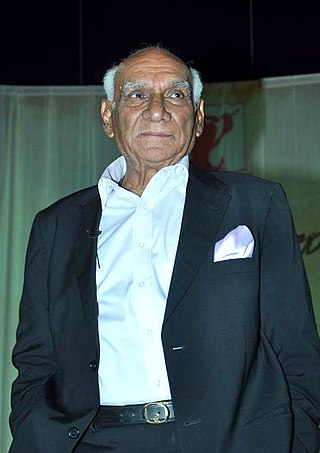
Yash Raj Chopra was an Indian film director and film producer who worked in Hindi cinema. The founding chairman of the film production and distribution company Yash Raj Films, Chopra was the recipient of several awards, including 6 National Film Awards and 8 Filmfare Awards. He is considered among the best Hindi filmmakers, particularly known and admired for his romantic films with strong female leads. For his contributions to film, the Government of India honoured him with the Dadasaheb Phalke Award in 2001, and the Padma Bhushan in 2005. In 2006, British Academy of Film and Television Arts presented him with a lifetime membership, making him the first Indian to receive the honour.

Kapila Vatsyayan was a leading scholar of Indian classical dance, art, architecture, and art history. She served as a member of parliament and bureaucrat in India, and also served as the founding director of the Indira Gandhi National Centre for the Arts.
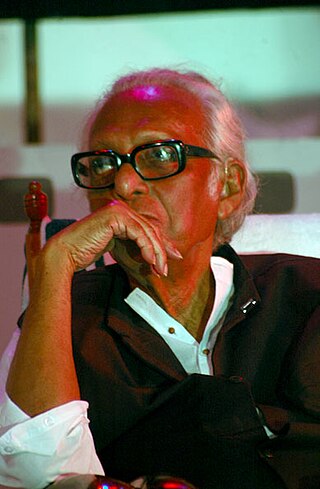
Mrinal Sen was an Indian film director and screenwriter known for his work primarily in Bengali, and a few Hindi and Telugu language films. Regarded as one of the finest Indian filmmakers, along with his contemporaries Satyajit Ray, Ritwik Ghatak, and Tapan Sinha, Sen played a major role in the New Wave cinema of eastern India.

Maqbool Fida Husain was an Indian artist known for executing bold, vibrantly coloured narrative paintings in a modified Cubist style. He was one of the most celebrated and internationally recognised Indian artists of the 20th century. He was one of the founding members of Bombay Progressive Artists' Group. M.F. Husain is associated with Indian modernism in the 1940s. His early association with the Bombay Progressive Artists' Group used modern technique, and was inspired by the "new" India after the partition of 1947. His narrative paintings, executed in a modified Cubist style, can be caustic and funny as well as serious and sombre. His themes—sometimes treated in series—include topics as diverse as Gandhi, Mother Teresa, the Ramayana, the Mahabharata, the British Raj, and motifs of Indian urban and rural life. In September 2020, his painting titled “Voices”, auctioned for a record $2.5 million.

Hrishikesh Mukherjee was an Indian film director, editor and writer. He is regarded as one of the greatest filmmakers of Indian cinema. Popularly known as Hrishi-da, he directed 42 films during his career spanning over four decades, and is named the pioneer of the 'middle cinema' of India. Renowned for his social films that reflected the changing middle-class ethos, Mukherjee "carved a middle path between the extravagance of mainstream cinema and the stark realism of art cinema".

Waheeda Rehman is an Indian actress. Regarded as one of Hindi cinema's most accomplished actresses, she has worked in more than 90 feature films, in a career spanning over five decades. Her accolades include a National Film Award and three Filmfare Awards. She was honoured with India's civilian awards; the Padma Shri in 1972 and the Padma Bhushan in 2011. In 2021 she was honoured with the Dadasaheb Phalke Award, India's highest award in the field of cinema, but was awarded in 2023.
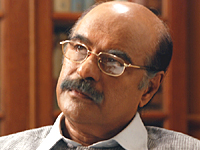
Gopynathan Velayudhan Nair, popularly known by the stage name Bharat Gopy, was an Indian actor, producer, and director. Considered one of the greatest actors in the history of Indian cinema, Gopy was one of the first actors to be associated with the New Wave cinema movement in Kerala during the 1970s.

Raakhee Gulzar, professionally known as Raakhee, is a popular Indian actress who has appeared in Hindi and Bengali films. In her four decades of acting, she has worked in more than 100 films. Raakhee has won several awards including two National Film Awards and three Filmfare Awards. In 2003, she received Padma Shri, India's fourth-highest civilian award.
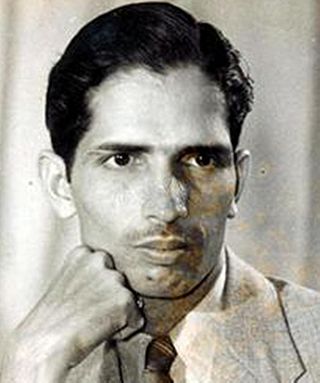
Kattingeri Krishna Hebbar was an Indian painter and art educator. He is well known for his paintings that captured the social life of the common people in India. Inspired by traditional Indian art, he combined the Western art techniques with his paintings to create a unique style of his own. Painting for Hebbar was about being true to the original self and this is what he tried to achieve in his works. In addition to his paintings, he is also known for his rhythmic line drawings and illustrations.
Alarmel Valli is an Indian classical dancer and Bharatanatyam-Pandanallur choreographer.
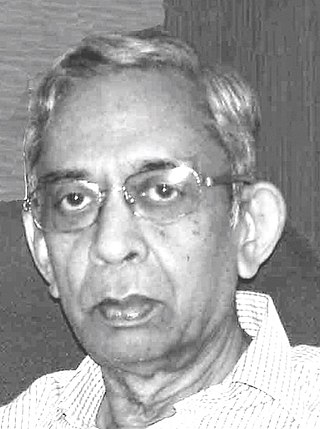
Ram Mohan was an Indian animator, title designer and design educator, who was also known as father of Indian Animation and was a veteran in the Indian animation industry, who started his career at the Cartoon Films Unit, Films Division of India, Government of India in 1956. He was chairman and chief creative officer at Graphiti Multimedia, a Mumbai-based animation company which was established in 1995, and later he also established the Graphiti School of Animation in 2006.
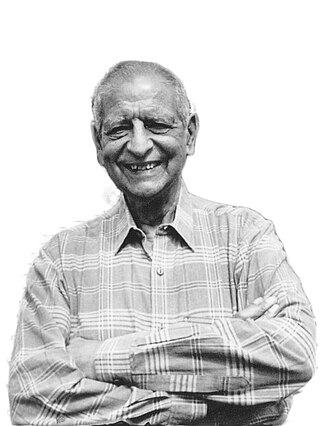
Kekoo Gandhy was an Indian art gallerist, art collector and art connoisseur, who pioneered the promotion of Indian modern art from the 1940s. He established Chemould Frames, a frame manufacturing business in 1941, soon he started displaying works of young modern artists K. H. Ara, S. H. Raza, K. K. Hebbar and M. F. Husain in his showroom windows. This led to gradual rise of modern art movement and post-colonial art in India. Eventually Gallery Chemould, India's first commercial art gallery, was opened in 1963 on the first floor of the Jehangir Art Gallery.
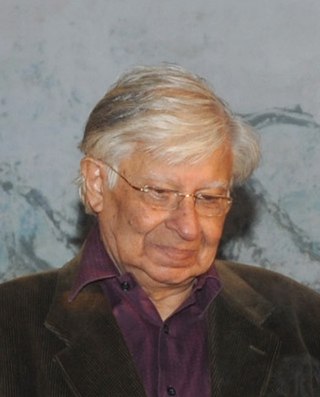
Krishen Khanna is an Indian painter known for his abstracted figurative artworks depicting street scenes of the country. He is a self-taught artist whose paintings showcase Indian idioms and human values. Notable works by Khanna include the Truckwallahs and Bandwallahs series as well as his paintings on Christian themes.

Nemai Ghosh was a noted Indian photographer most known for working with Satyajit Ray, as a still photographer for over two decades, starting with Goopy Gyne Bagha Byne (1969) till Ray's last film Agantuk (1991).
Minati Mishra was an Indian classical dancer and actress, known for her expertise in the Indian classical dance form of Odissi. She was reported in 2011 to be the oldest-living Odissi performer. The Government of India honored Mishra in 2012, with the fourth-highest civilian award of Padma Shri.
Gitchandra Tongbra, popularly known as G. C. Tongbra, was an Indian satirist, poet, playwright and art academic from Imphal. Born on 6 February 1913 in the Indian state of Manipur, Tongbra was known for his socio-realistic plays such as Mani Manou (1962), Matric Pass (1964) and Upu Baksi (1972).
Shanti Dave is an Indian painter and sculptor, considered by many as one of the major Indian artists of the twentieth century. He is a former member of the Lalit Kala Akademi and the Sahitya Kala Parishad. The Government of India awarded him the fourth highest Indian civilian honour of Padma Shri in 1985.
Biren De (1926–2011) was an Indian painter of modern art, known for his paintings with tantric influences. His paintings were characterized by symmetrical patterns of geometry and the presence of tantric symbols such as mandala, phallus and vagina, reportedly representing masculine and feminine energies of the universe. The Government of India awarded him the fourth highest civilian honour of the Padma Shri in 1992.
References
- ↑ A Dream Turns Seventy Five: The Modern School, 1920-1995. Allied Publishers. 2015. ISBN 9788170234999 . Retrieved 25 September 2015.
- ↑ Shiela Gujral (2002). My Years in the USSR. MacMillan. p. 179. ISBN 9780333938126.
- ↑ Krishna Chaitanya (1976). A History of Indian Painting: The modern period. Abhinav Publications. p. 330. ISBN 9788170173106.
- ↑ "Indian Abstracts: An Absence of Form". 40to40. 2015. Archived from the original on 25 September 2015. Retrieved 25 September 2015.
- ↑ "Mutual Art info". Mutual Art.com. 2015. Retrieved 25 September 2015.
- ↑ "20th National Film Awards". International Film Festival of India. Archived from the original on 5 November 2013. Retrieved 26 September 2011.
- ↑ "22nd National Film Awards (PDF)" (PDF). Directorate of Film Festivals . Retrieved 1 October 2011.
- ↑ "Padma Awards" (PDF). Ministry of Home Affairs, Government of India. 2015. Archived from the original (PDF) on 15 October 2015. Retrieved 21 July 2015.